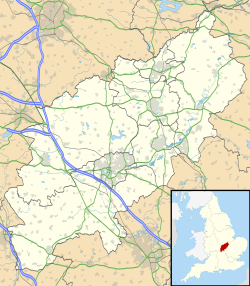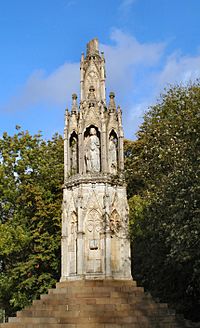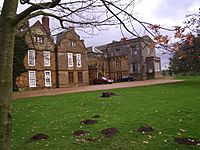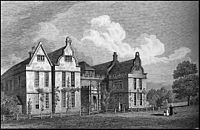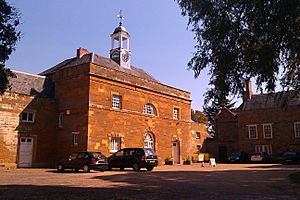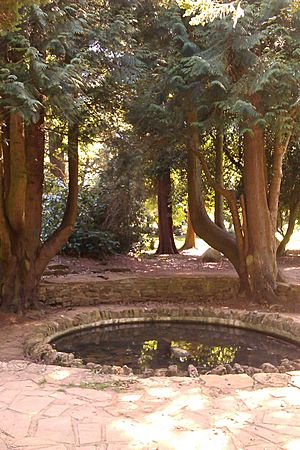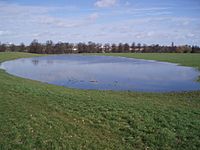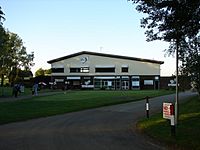Delapré Abbey facts for kids
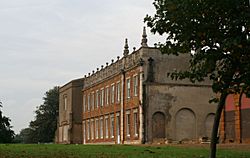
Delapré Abbey - the south facade
|
|
| Monastery information | |
|---|---|
| Full name | Abbey of St Mary de la Pré The Abbey of St Mary in the Meadow |
| Order | Cluniac Nuns |
| Established | c. 1145 |
| Disestablished | 1538 |
| Mother house | Abbey of Cluny |
| Dedicated to | St Mary de la Pré, Sancta Maria de pratis, St Mary in the Meadows |
| Diocese | Lincoln |
| People | |
| Founder(s) | Simon de Senlis, 4th Earl of Huntingdon and Northampton |
| Site | |
| Location | Hardingstone (extreme north of), Northampton |
| Coordinates | 52°13′29″N 0°53′22″W / 52.2247°N 0.8895°W |
| Visible remains | None |
| Public access | Yes |
Delapré Abbey is a beautiful old building in Northamptonshire, England. It looks like a grand house, but it actually has a long history. Part of the building used to be a monastery, which is a place where religious people live and work together.
This monastery was called the Abbey of St Mary de la Pré. The name means "St Mary in the Meadow" because it was located near the River Nene, about one mile south-east of Northampton. It was founded around 1145 as a nunnery, a monastery specifically for nuns. These nuns followed the rules of the famous Cluny Abbey in France.
The large grounds around Delapré Abbey are also very important. They are a protected national battlefield. This is because a big fight from the Wars of the Roses happened here. It was the Battle of Northampton (1460), where the Yorkist army advanced.
Contents
Building the Abbey and its Wealth
The Abbey was started by Simon de Senlis, 4th Earl of Huntingdon and Northampton, a powerful Anglo-Norman Earl. This happened during the time of King Stephen. Later, King Edward III gave the Abbey a special Royal Charter, which was like an official permission document.
When it was first built, the Abbey was given a lot of land, about 3,060 acres. This land was in the area of Hardingstone. The Abbey also controlled churches in places like Earls Barton, Great Doddington, and Fotheringhay. This meant they could choose the priests for these churches. King Edward I also added more churches to Delapré's control. He even gave wood to help repair the Abbey's church and dining hall.
Life at the Abbey
Delapré was one of only two nunneries in England that followed the rules of Cluny Abbey. The Cluniac order was a special group of Benedictine monks and nuns who wanted to live a very strict religious life. Usually, about 12 to 20 nuns lived at Delapré Abbey at any one time.
The local Guild of Weavers in Northampton had a tradition. Every Easter Monday, they would walk to the Abbey church. There, they would offer candles in front of the statues of the Holy Trinity and the Virgin Mary.
The Abbey was also known for its charity. From the very beginning, it gave money, bread, and fish to the poor every year. Later, they received more donations and gave even more help.
However, in 1538, the Abbey had to close down. This was part of the Dissolution of the Monasteries ordered by King Henry VIII. After it closed, the building was used as a private home for many years. During World War II, it was even used by the military. For a long time, it was home to the Northamptonshire Record Office, which kept important historical documents.
Today, Delapré Abbey is a Grade II* listed building, meaning it's very important for its history. It has a shop and a café, and the main building is now open for tours, educational visits, and even weddings! The Delapré Abbey Preservation Trust takes care of the buildings.
Important Moments in History
The Eleanor Cross
You can find one of the famous Eleanor Crosses in the grounds of Delapré Abbey. There were originally twelve of these crosses built across England. They were put up by King Edward I to mark the places where the body of his beloved wife, Queen Eleanor of Castile, rested on its journey from Lincoln to London after she died.
Queen Eleanor's body stayed at Delapré Abbey for a night in 1290. The cross here is an octagonal (eight-sided) stone tower with beautiful carvings and statues. It was started in 1291 by John of Battle, and William of Ireland helped carve the statues. The lower part of the cross might have had prayers for the Queen. The Abbey grounds are a Scheduled Ancient Monument because of their historical importance, including being a battlefield.
Timeline of Delapré Abbey
- 1145 - Delapré Abbey was built by Simon, the son of Simon de Senlis, the 2nd Earl of Northampton.
- 1290 - Queen Eleanor of Castile, wife of King Edward I, died. Her funeral procession stopped at Delapré Abbey for a night on its way to Westminster Abbey. The King stayed at Northampton Castle. The next day, an Eleanor Cross was built on a nearby hill to mark the spot.
- 1460 - The Battle of Northampton (1460) was fought on the Abbey grounds.
- 1538 - King Henry VIII forced the Abbey to close as part of the Dissolution of the Monasteries.
- 1543 - The Crown rented out the Abbey and its land.
- 1550 - The Crown sold the Delapré estate to the Tate family.
- 1756 - The Tate family sold the estate to the Bouverie family.
- 1940 - The War Office took over the Abbey during World War II.
- 1946 - The Northampton Corporation (now Northampton Borough Council) bought the estate.
- 1959 - The Northamptonshire Record Office officially opened at Delapré Abbey.
- 2012 - The clock on the stable block was repaired.
- 2018 - The Delapré Abbey Preservation Trust took over management, and the Abbey opened to the public for the first time in 900 years.
Who Owned Delapré Abbey?
Over the centuries, Delapré Abbey has had many owners:
- 1145-1538 - The Cluniac Order of Nuns
- 1539-1543 - King Henry VIII
- 1543-1548 - John Marsh
- 1548-1564 - Anne Saunders and her husband Andrew Wadham
- 1564-1750 - The Tate family (several generations)
- 1750-1756 - Charles Hardy
- 1756-1943 - The Bouverie family (several generations)
- 1946-2018 - Northampton Corporation (later Northampton Borough Council)
- 2018-present - Friends of Delapré Abbey
Leaders of the Abbey
The head of a nunnery is called an Abbess. Here are some of the Abbesses who led Delapré Abbey:
- Azelina (1145)
- Margery de Wolaston (1282-1296/97) - She was the Abbess when Queen Eleanor died.
- Katherine Knyvet (1333/34-1349) - She died from the plague.
- Gonora Downghton (died 1481) - She was the Abbess during the Battle of Northampton (1460).
- Clementina Stock (1504/05-1538) - She was the last Abbess before the Abbey closed.
The Abbey had a special seal that showed the coronation of the Virgin Mary.
The Battle of Northampton (1460)
The Battle of Northampton (1460) was fought right on the Abbey grounds, just north of the Abbey and south of the River Nene. After the battle, King Henry VI was captured. He spent the night of July 10, 1460, at the Abbey as a prisoner. The kind nuns at the Abbey helped care for the soldiers who were hurt in the battle. Many of those who died in the battle were buried in the nuns' graveyard, which is now the Abbey's walled garden.
After the Abbey Closed
In 1542, the Tate family bought the Abbey grounds. They started to create beautiful gardens. It's thought that an Elizabethan-style garden was laid out where the formal walled garden is today.
The Tate family lived at Delapré until 1764. Then, the Bouverie family bought the estate. Most of the buildings you see today were built or changed during their time. The gardens were also redesigned to look more natural, in the style of a famous landscape designer named Capability Brown. The Bouverie family also added fruit and vegetable gardens. Researchers believe the current walled garden is where the nuns were buried, as graves were found during its construction.
In the 1800s, more Victorian garden features were added, like rock and water gardens. They also built special conservatories (greenhouses) for growing peaches and grapes. A "ha-ha" was also built, which is a hidden ditch that acts as a fence without blocking the view. The buildings used for growing fruit are still there today.
Delapré Abbey Today
The Buildings
What you see of Delapré Abbey today is made up of four sections around a square courtyard. This courtyard was probably where the old cloisters were, which are covered walkways often found in monasteries.
Some of the very thick walls in the northern part of the main building might be from the original Abbey church. Not much of the old medieval Abbey buildings are left. However, two small spaces in the cloister walk might have been used to hold candles at night.
Most of the building you see now was built or changed between the 1500s and 1700s, with many updates in the 1800s. The stables, located at the northern end, were built around 1750-1765. They were updated in 1971.
As one historian said in 1937, "The present Delapré Abbey... has undergone so many alterations that it is not possible to give a connected history of its development, but it retains quite a considerable amount of ancient work."
Restoration Work
In 2013, the Abbey received a large grant from the Heritage Lottery Fund. This led to a £6.3 million restoration project that started in 2016. Thanks to this work, the Delapre Abbey Preservation Trust now manages the Abbey. It opened to the public for the first time in 900 years on March 17, 2018.
The Grounds
The Abbey has about 500 acres of parkland and 8 acres of more formal gardens. You can find many interesting things in the grounds, including:
- A ha-ha (a hidden ditch)
- A lake
- Delapré Woods
- Rock and water gardens
- Cool tree sculptures
Part of the estate is also used as the public Delapré Golf Course.
Sometimes, there have been issues with flooding in the grounds. In 2007, a flood lake appeared after some earth mounds (called bunding) were built to stop cars from driving onto the grounds. People were worried about the flooding, and there have been discussions about removing the mounds.
The Formal Garden
In 1977 and 1978, three sculptures were placed in the walled garden:
- "The Lady with Kittens" and "The Lovers" were made by Walter Ritchie. These large brick sculptures show scenes from the life of a made-up character named Sarah Wellington-Gore. They were given to Northampton after an exhibition in London.
- "Woman and the Fish" is a famous sculpture by Frank Dobson, a respected British sculptor. This sculpture was given to Northampton after the Festival of Britain in 1951. It used to be in the town centre but was damaged. It was repaired and moved to the Abbey's garden after people raised money for its restoration.


